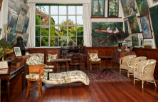Claude Monet had relentlessly high standards
Author and art historian Pascal Bonafoux is one of the most distinguished Claude Monet experts. He generously, and with great clarity, shares with us his thoughts about the artist and the man.

As it emerged and grew, the impressionist movement completely broke with the classical rules of art in the 19th century. But are we right in presenting it as a revolutionary movement?
Our way of recording art history is often caricatural. It is all black and white, but we should use shades of grey! So if you take a close look at the words of Monet or Renoir, you can discover the extraordinary influence that 18th century artworks, such as those by Fragonard, had on both of them. These great artists have the particularity of being the heirs to a tradition and of breathing new life into it.
In 2010, you published a book ‘Claude Monet, peintre de l’eau’ (Editions du Chêne). Could we say that water (‘eau’ in French) is the underlying theme of his work?
Without a doubt. And the grand finale of his work was when he had the water lily pond dug at Giverny. The Channel, Mediterranean, Seine and this Giverny pond: water is the theme flowing through all his work! For him, this was the most immense challenge of them all. Capturing the light that so fascinated him, through water.
Was Claude Monet’s move to Giverny, where he invented his own motif, a determining step in the development of his artwork?
So much happened when he moved to Giverny! Claude Monet found a reasonably priced house that he wouldn’t have been able to afford in Paris. Moving there also enabled him to distance himself. His relationship with Alice, who was still married to Ernest Hoschedé, was deemed immoral by the standards of that period! Furthermore, and thanks to Paul Durand-Ruel, Claude Monet quickly gained the financial means to change his life. Just think of the audacity of that art dealer heading to New York with some 300 paintings under his arm! It was a deal changer. Claude Monet became famous in the United States and enjoyed the totally novel experience of being in a comfortable financial position. He was finally able to realise the dream that had, until then, been out of reach.
The atmosphere and light in Normandy forged Claude Monet’s paintings. But the Giverny artist still travelled often with his paint brushes and easel to Norway, London, Bordighera, Venice and elsewhere. What was he seeking?
He needed to seek out new challenges. Could he tackle the northern countries’ glaciers? The Mediterranean’s dazzling light? Each time, Monet was amazingly bold in challenging himself to depict different places and lights. He wanted to push himself beyond what he already knew.
Letters by Claude Monet highlight how dismayed and angry he could get when faced with a motif he was failing to capture. For the artist, was painting almost a sort of suffering?
These letters, which I would love to see republished, are in fact interspersed with anger and rancour from a Monet enraged that he could not do what he wanted. That’s what drove him to put his foot through a painting. His pride was such that he could not tolerate that which for others would be acceptable. He had to achieve the exceptional. He had such an awareness of the value of what he was painting that his standards were relentlessly high. He had such high ideals of what he had to produce.
Were those relentlessly high standards hiding another, more unexpected character trait?
Claude Monet was very generous and extraordinarily inclusive. The first person who bought a painting by Cézanne, an artist who everyone looked down on and sneered at, was Monet in 1895! And who came to the family’s rescue when Sisley died? Monet. Who helped Pissarro when he was thrown out of his house? Who started a subscription to ensure Olympia stayed in France and was gifted to the state? It is hard to find a more generous person.
The public’s enthusiasm for Monet’s work has never been in question. How can his modern appeal be explained?
Because he is indecipherable. Geniuses have the particularity of always generating the need to reinterpret their work. Given a Monet, you don’t know what you are dealing with. The artist André Masson said about the Grandes Décorations in the Orangerie: “Go see those rooms, where you don’t know if the painting finishes or starts there.” The artwork remains not enigmatic, as that would mean it can never be understood, but mysterious. Mystery is its crucial element and what continues to fascinate people.
Fondation Monet sets the scene of his life so we can better understand the man and the artist. What do you feel when you stroll around it?
There are two places in this wonderfully maintained Fondation that I love the most. Firstly, the large living room with its reproductions of Monet artworks. Here we can see the master impressionist’s painting history. The second place is his bedroom and washroom. Here, conversely, we see Monet as an enthusiast and collector. The man who recognised, admired and supported others generously. It’s fascinating to see both his own history on the ground floor and, on the upper floor, the extraordinary intelligence of a man who took on challenges tackled by others!
Who are the artistic heirs of Monet today?
Let me tell you, with a bonus paradox, that the man who’s 100th birthday we are celebrating is possibly one of the most extraordinary heirs of Monet’s legacy, as he seeks the same thing: light. This is the most splendid example of the amazing thread running through the history of painting: from Claude Monet to Pierre Soulages.
The current fashion is for immersive exhibitions (projecting digitised artworks on walls and floors). What do you think of this concept combining art and technology?
If these exhibitions encourage visitors to then go to a museum to see the original artworks, that’s great and why not! But I fear that this concept actually distances them and that we are restricting ourselves to a show that has nothing in common with the actual paintings. If they only say “It’s not bad” and nothing more, that’s deplorable. That type of immersion resembles a by-product. Just because you drink from a Van Gogh cup at breakfast does not mean that you know Van Gogh!














